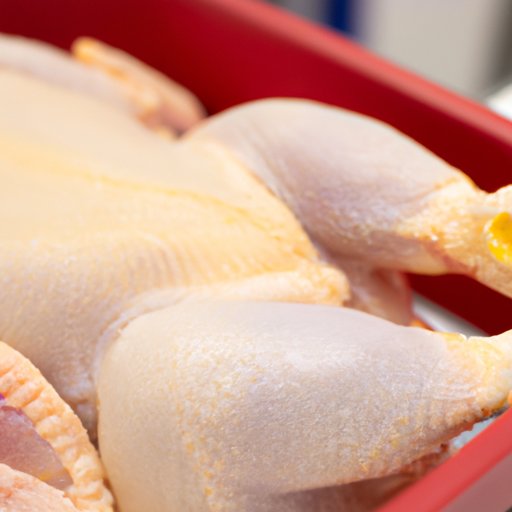
I. Introduction
Chicken is a popular and versatile ingredient in many households, but it’s essential to handle it safely to prevent foodborne illnesses. One common question that arises when cooking chicken is whether you can refreeze it after thawing. Let’s dive into this topic and explore the safety guidelines, debunk the myths, and learn how to handle chicken safely.
A. Explanation of the Problem
When chicken is thawed, the ice crystals inside it melt, creating the perfect environment for bacteria to multiply. Refreezing chicken after thawing can lead to bacterial growth, making the food unsafe to eat. It’s essential to handle chicken safely to prevent bacteria growth and foodborne illnesses.
B. Purpose of the Article
The purpose of this article is to provide a comprehensive guide on the safety guidelines, debunk the myths, and provide proper thawing and refreezing techniques for chicken. We’ll discuss the science behind refreezing chicken, and how it impacts the safety and quality of the meat, and provide tips on meal planning with refrozen chicken after thawing.
C. Importance of Safe Handling of Chicken
Safe handling of chicken is essential to prevent foodborne illnesses. According to the Centers for Disease Control and Prevention, about one in six Americans get sick from foodborne illnesses every year, resulting in 128,000 hospitalizations and 3,000 deaths. Safe handling practices, including proper storage, thawing, and cooking, can prevent the spread of bacteria and keep our families safe.

II. Safety Guidelines for Refreezing Chicken After Thawing: A Comprehensive Guide
A. Explanation of Why Refreezing Chicken is a Concern
As mentioned above, when chicken is thawed, the ice crystals inside it melt, creating the perfect environment for bacteria to multiply. Refreezing chicken after thawing can lead to additional bacterial growth, increasing the risk of foodborne illnesses. It’s essential to handle chicken correctly to prevent bacterial growth.
B. Guidelines for Handling Thawed Chicken
- Storage Temperature: When thawing chicken, it’s essential to store it at a safe temperature. The refrigerator is the safest option for thawing and storing chicken. Keep the temperature below 40°F to slow the growth of bacteria.
- Duration of Storage: Once chicken is thawed, it should be cooked within two days. If you don’t plan to cook the chicken within two days, you can refreeze it but at the risk of quality and safety loss.
- Safe Cooking Temperatures: Cook chicken to a safe temperature of at least 165°F, regardless of whether it’s fresh or refrozen. Use a food thermometer to ensure it reaches the proper temperature for both safety and quality purposes.
C. Tips for Avoiding Common Mistakes when Handling Thawed Chicken
- Don’t leave chicken at room temperature for more than two hours.
- Don’t refreeze chicken that has been left at room temperature for more than two hours.
- Don’t refreeze chicken that has been in the refrigerator for more than 2-3 days.
- Don’t rely on the color of the chicken to determine whether it’s safe to eat. Always use a food thermometer to check the temperature.
III. Debunking the Myth: Experts Explain Whether Chicken Can be Refrozen After Thawing
A. Explanation of the Common Myth about Refreezing Chicken
One of the most common myths about refreezing chicken is that it’s unsafe and can lead to foodborne illnesses. Let’s explore whether this is true.
B. Quote from Food Safety Expert on the Safety of Refreezing Chicken
According to the USDA, it’s safe to refreeze chicken if it’s been thawed in the refrigerator. Refreezing will not cause bacteria growth if the chicken has been stored at a safe temperature of 40°F or below. However, the quality of the meat may suffer with its texture and flavor changing.
C. Clearing up Confusion about the Effects of Refreezing on Chicken Quality and Safety
While refreezing chicken is generally safe from a bacterial growth standpoint, it’s important to note that the quality of the meat may suffer. When chicken is thawed, the ice crystals inside it expand and damage the cell walls. Refreezing the chicken can cause the ice crystals to expand again, causing the damage to the cell walls to worsen and resulting in a loss of quality and flavor.
IV. Proper Thawing and Refreezing Techniques for Chicken: Tips from the Pros
A. Explanation of the Importance of Proper Thawing Techniques
Proper thawing techniques are essential for preventing bacterial growth and maintaining the quality of the chicken.
B. Tips for Thawing Chicken Safely
- Refrigerator Thawing: This is the safest method to thaw chicken. Place the chicken in a dish in the refrigerator for 24-48 hours for every four or five pounds of meat.
- Cold Water Thawing: If you don’t have time to thaw chicken in the refrigerator, you can thaw it in cold water. Place the chicken in a leak-proof bag and submerge it in cold water for 30 minutes per pound. Replace the water every 30 minutes until the chicken is fully thawed.
- Microwave Thawing: Thawing chicken in the microwave is the quickest method, but it’s not recommended because it can create hot spots, which can lead to bacterial growth. If you must use this method, follow the manufacturer’s instructions and cook the chicken immediately after thawing.
C. Techniques for Refreezing Chicken Safely
- Separate the chicken into smaller pieces before refreezing. This will allow it to thaw more evenly and quickly when you’re ready to cook it.
- Wrap the chicken tightly in plastic wrap or aluminum foil, then place it in a freezer bag. Squeeze out as much air as possible to prevent freezer burn.
- Label the bag with the date it was refrozen and the date it needs to be used by so you can track it properly.
V. The Science Behind Refreezing Chicken: Separating Fact from Fiction
A. Explanation of How Chicken Quality Can be Impacted by Refreezing
Refreezing chicken can impact the quality of the meat. As mentioned earlier, when chicken is thawed, the ice crystals inside it expand and damage the cell walls. Refreezing the chicken can cause the ice crystals to expand again, causing the damage to the cell walls to worsen and resulting in a loss of quality and flavor.
B. Discussion of Recent Studies on the Safety of Refreezing Chicken
According to recent studies, refreezing chicken is generally safe from a bacterial growth standpoint if the chicken has been stored at a safe temperature of 40°F or below. However, it’s essential to maintain the quality of the meat by following proper thawing and refreezing techniques.
C. Explanation of Factors That Can Affect the Safety and Quality of Refrozen Chicken
- Temperature during storage
- Duration of storage
- Proper thawing techniques
- How the chicken was prepared before freezing
VI. How to Save Money and Limit Food Waste by Refreezing Chicken
A. Explanation of How Refreezing Chicken Can Save Money and Reduce Food Waste
Refreezing chicken can help you save money and limit food waste by allowing you to use all the chicken you buy without worrying about it going bad. It’s essential to handle it properly to maintain its quality and safety.
B. Tips for Using Refrozen Chicken in Cooking
- Use refrozen chicken in recipes that are cooked for a long time, such as stews and soups, to help mask changes in the texture and flavor of the meat.
- Season refrozen chicken well to enhance the flavor.
C. Tips for Cooking Refrozen Chicken Safely and Deliciously
- Cook it to a safe temperature of at least 165°F.
- Use a meat thermometer to check the temperature.
- Cook it slowly over low heat for the best results.
VII. Tips for Meal Planning with Refrozen Chicken After Thawing
A. Explanation of How to Include Refrozen Chicken in Meal Planning
Meal planning is a great way to save time and money. You can include refrozen chicken in your meal plan by incorporating it into meals that are cooked for a long time.
B. Ideas for Meal Prep and Bulk Cooking with Refrozen Chicken
- Cook a large batch of chicken and freeze it in meal-sized portions for easy meal prep.
- Use refrozen chicken in casseroles, stir-fries, and pasta dishes.
- Make chicken stock with the bones and freeze it for later use.
C. Conclusion and Call to Action
Refreezing chicken after thawing can be safe and cost-effective if you handle it properly. It’s essential to follow the safety guidelines, debunk the myths, and learn proper thawing and refreezing techniques to maintain the quality and safety of the meat. Let’s keep our families safe and reduce food waste by following these guidelines.
VIII. Conclusion
A. Recap of Main Points
- Refreezing chicken after thawing can be safe if handled properly.
- Safe guidelines for handling thawed chicken include storage temperature, duration of storage, and safe cooking temperatures.
- Proper thawing techniques and refreezing techniques are crucial for maintaining the quality and safety of the meat.
- Refreezing chicken can save money and reduce food waste, but it’s essential to handle it correctly.
B. Final Thoughts on Refreezing Chicken After Thawing
Refreezing chicken after thawing can be safe and cost-effective if you handle it properly. It’s essential to follow the safety guidelines, debunk the myths, and learn proper thawing and refreezing techniques to maintain the quality and safety of the meat. Let’s keep our families safe and reduce food waste by following these guidelines.
C. Encouragement to Follow Safety Guidelines for Handling Chicken
Safe handling practices are crucial for preventing foodborne illnesses. Let’s all commit to following the safety guidelines for handling chicken and other meats to maintain the health and safety of our families.





